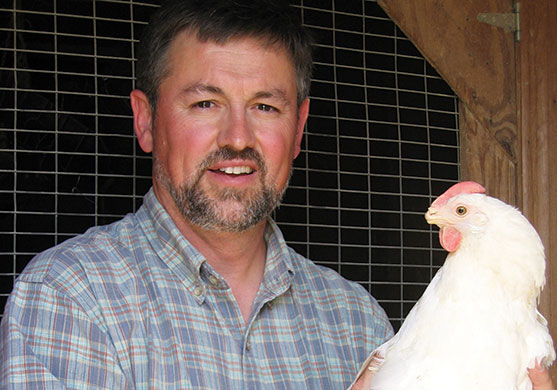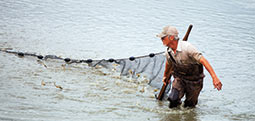| Current Issue | Past Issues | Subscribe | Ag Homepage |

Taking on Tumors
Uterine Fibroids
by
An estimated 70 percent of women in the U.S. develop fibroid tumors in the uterus by age 50, and while the noncancerous tumors cause no symptoms for the majority of those women, they make life miserable for tens of thousands of others.
Within his own family, Wallace Berry has seen the pain and distress that uterine fibroids can inflict, and in his newest research undertaking, the Auburn University poultry scientist aims to use his findings to help reduce the incidence and severity of fibroid tumors.
Using the laying hen as an experimental model, he and Haruka Wada, an Auburn biological sciences assistant professor specializing in the short- and long-term effects of pre- and postnatal developmental stress in birds and other animals, are investigating their theory that overnutrition during infancy and childhood and early onset of puberty increase a woman’s chances of developing uterine fibroids.
Berry’s expertise is in the reproductive physiology of poultry, and in extensive research over the past decade, he has established the egg-type chicken—the hormonal cycle and ovarian surface cells of which are remarkably similar to humans’—as a scientifically valid animal model for studying human reproductive-tract disorders, including ovarian cancer and uterine fibroids. Through the years, he also observed that, among hens 2 years of age and older, the rate of oviductal fibroid tumors is extremely high. Most recently, work in his lab yielded evidence that molecular markers in hen oviduct fibroids are identical to those in human uterine fibroids.
“Uterine fibroids are a huge quality of life issue for a large segment of the population, but little progress has been made in determining what causes the disease or recommendations for prevention, in part due to a lack of experimental models for study of it,” Berry said. “Dr. Wada has formulated the hypothesis for our study, which is among the first to examine how the developmental environment, such as childhood diet, impacts a woman’s risk for the disease.”
Fibroids are most common in women in their 30s and 40s. Depending on a tumor’s size and location in the uterus, it can cause symptoms including abdominal pain and pressure, bloating, heavy or prolonged menstrual bleeding, backache and, in rare cases, infertility.
Although a few new experimental treatment procedures have become available in recent years, fibroids still are a major cause of hysterectomies in the U.S., accounting for a third of the 600,000 performed each year. The annual cost of hospitalizations, surgeries, lost work hours and pregnancy complications due to uterine fibroids is estimated at $34.4 billion.
Past research has shown that developmental nutrition affects both childhood body composition and age at puberty by altering the programing of the insulin-like growth factor system, which plays a significant role in tissue growth and development. Scientists have found, too, that the younger a female is when she reaches puberty, the greater her chances of developing uterine fibroids later in life.
“Our question is, what is the relationship among all those parameters,” Berry said. “Our theory is that a high or excessive level of postnatal nutrition contributing to early onset of sexual maturity increases the risks of uterine fibroids by altering IGF regulation and cell proliferation signals.”
To explore the causal relationship between developmental nutrition and fibroid tumors, the scientists have developed test diets they will feed to six groups of test hens from 1 day of age and regularly monitor serum IGF levels in the birds. They also will use the hens as models to explore fibroid development in relation to early or late sexual maturity.
“This is another reason why hens are an excellent model species: it’s easy to either speed up or delay the onset of sexual maturity by manipulating the diet and lighting conditions in their houses,” Berry said. “Hens kept on short days of eight hours of light a day lay their first egg 13 days later than those on long days of 14 hours of light a day.”
A $40,000 Alabama Agricultural Experiment Station grant is funding the fibroid study. Berry said he and Wada will use data they collect from the project to apply for a substantially larger grant from a National Institutes of Health/U.S. Department of Agriculture funding program specifically for projects that use agriculturally important domestic animal species to improve human health through the advancement of basic and translational research that is highly relevant to both agricultural and biomedical research.
“We also will use our data to help establish recommendations for nutrition during infancy and the prepubertal period that could help prevent and lessen the severity of uterine fibroid tumors,” Berry said.









Connect With Us!